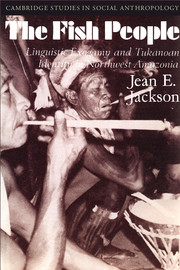Book contents
- Frontmatter
- Contents
- List of figures, maps, and tables
- Preface
- Acknowledgments
- Note on orthography
- 1 Purpose and organization of the book
- 2 Introduction to the Central Northwest Amazon
- 3 The longhouse
- 4 Economic and political life
- 5 Vaupés social structure
- 6 Kinship
- 7 Marriage
- 8 Tukanoans and Makú
- 9 The role of language and speech in Tukanoan identity
- 10 Male and female identity
- 11 Tukanoans' place in the cosmos
- 12 Tukanoans and the outside world
- 13 Conclusions: themes in Tukanoan social identity
- Notes
- Glossary
- References
- Index
- CAMBRIDGE STUDIES IN SOCIAL ANTHROPOLOGY
5 - Vaupés social structure
Published online by Cambridge University Press: 05 June 2012
- Frontmatter
- Contents
- List of figures, maps, and tables
- Preface
- Acknowledgments
- Note on orthography
- 1 Purpose and organization of the book
- 2 Introduction to the Central Northwest Amazon
- 3 The longhouse
- 4 Economic and political life
- 5 Vaupés social structure
- 6 Kinship
- 7 Marriage
- 8 Tukanoans and Makú
- 9 The role of language and speech in Tukanoan identity
- 10 Male and female identity
- 11 Tukanoans' place in the cosmos
- 12 Tukanoans and the outside world
- 13 Conclusions: themes in Tukanoan social identity
- Notes
- Glossary
- References
- Index
- CAMBRIDGE STUDIES IN SOCIAL ANTHROPOLOGY
Summary
The settlement
At 0.2 inhabitants per square kilometer (Instituto Geográfico “Agustín Codazzi,” 1969, p. xii), the population density of the Vaupés is comparable to that of many hunter–gatherer groups as well as to the more sparsely populated horticulturalist societies in New Guinea (Glasse and Meggitt, 1965). Thus, although Tukanoan settlements are concentrated on or near rivers and streams, they are still extremely isolated, an isolation compounded by the difficulty of traveling either by river or by land. Longhouses currently hold approximately 20 to 40 people (some of these are children who attend mission school for up to eleven months of the year). Nucleated villages have anywhere from 12 to approximately 60 inhabitants, and some mission towns have more than 100 people.
The census I took in 1968–70 shows approximately 165 settlements for the region south of the Vaupés River, including the Papurí River and its tributaries, the Tiquié above Buena Vista, and the Pirá-paraná above Carurú Rapids. In 1970 this figure included 24 longhouses. The remaining settlements are a variety of arrangements, from one- or two-family groups to large mission towns, so making generalizations about the Vaupés settlements is somewhat tricky. Although the majority of settlements are nucleated villages, these do not necessarily represent a simple changeover from longhouse to several small one-family houses containing the same inhabitants. As has been pointed out, several longhouse groups, or segments of them, may make up one of the larger villages.
- Type
- Chapter
- Information
- The Fish PeopleLinguistic Exogamy and Tukanoan Identity in Northwest Amazonia, pp. 69 - 104Publisher: Cambridge University PressPrint publication year: 1983

